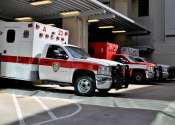Researchers call for enhanced research into common post-stroke condition
Lateropulsion, a clinical condition that results in the body leaning to one side, affects about half of all stroke survivors.
Apr 23, 2024
0
26
Lateropulsion, a clinical condition that results in the body leaning to one side, affects about half of all stroke survivors.
Apr 23, 2024
0
26

Every year, between 250,000 and 300,000 people in Germany suffer from a stroke or heart attack. These patients suffer immune disturbances and are very frequently susceptible to life-threatening bacterial infections. Until ...
Apr 23, 2024
0
11

From 2000 to 2022, there was an increase in the lifetime risk for atrial fibrillation, according to a study published online April 17 in The BMJ.
Apr 22, 2024
0
0

Another broiling summer looms, along with another season of kids' summer sports.
Apr 22, 2024
0
0

In an ischemic stroke, an artery in the brain is blocked by blood clots and the brain cells can no longer be supplied with blood as a result. Doctors must therefore act quickly and unblock the artery with the help of catheters. ...
Apr 19, 2024
0
1

Managing a stroke victim's blood sugar levels after they receive powerful clot-busting drugs might help them survive their health crisis, a new trial finds.
Apr 19, 2024
0
1

A study appearing in MedComm has been led by Dr. Jizong Zhao, Dr. Dong Zhang, and Dr. Peicong Ge (Department of Neurosurgery, Beijing Tiantan Hospital, Capital Medical University and Department of Neurosurgery, Beijing Hospital). ...
Apr 18, 2024
0
6

The lifetime risk of atrial fibrillation (a heart condition that causes an irregular and often abnormally fast heart rate) has increased from one in four to one in three over the past two decades, finds a study from Denmark ...
Apr 17, 2024
0
134

Whether reeling from a sudden stroke or buckling under the sustained assault of Alzheimer's, the brain becomes inflamed, leading to cognitive problems and even death.
Apr 12, 2024
0
64

A changing climate may be linked to growing death and disability from stroke in regions around the world, according to a study published in the April 10, 2024, online issue of Neurology.
Apr 10, 2024
0
0

A stroke is the rapidly developing loss of brain function(s) due to disturbance in the blood supply to the brain. This can be due to ischemia (lack of blood supply) caused by thrombosis or embolism or due to a hemorrhage. As a result, the affected area of the brain is unable to function, leading to inability to move one or more limbs on one side of the body, inability to understand or formulate speech, or inability to see one side of the visual field. In the past, stroke was referred to as cerebrovascular accident or CVA, but the term "stroke" is now preferred.[citation needed]
A stroke is a medical emergency and can cause permanent neurological damage, complications, and death. It is the leading cause of adult disability in the United States and Europe. In the UK, it is the second most common cause of death, the first being heart attacks and third being cancer. It is the number two cause of death worldwide and may soon become the leading cause of death worldwide. Risk factors for stroke include advanced age, hypertension (high blood pressure), previous stroke or transient ischemic attack (TIA), diabetes, high cholesterol, cigarette smoking and atrial fibrillation. High blood pressure is the most important modifiable risk factor of stroke.
The traditional definition of stroke, devised by the World Health Organization in the 1970s, is a "neurological deficit of cerebrovascular cause that persists beyond 24 hours or is interrupted by death within 24 hours". This definition was supposed to reflect the reversibility of tissue damage and was devised for the purpose, with the time frame of 24 hours being chosen arbitrarily. The 24-hour limit divides stroke from transient ischemic attack, which is a related syndrome of stroke symptoms that resolve completely within 24 hours. With the availability of treatments that, when given early, can reduce stroke severity, many now prefer alternative concepts, such as brain attack and acute ischemic cerebrovascular syndrome (modeled after heart attack and acute coronary syndrome respectively), that reflect the urgency of stroke symptoms and the need to act swiftly.
A stroke is occasionally treated with thrombolysis ("clot buster"), but usually with supportive care (speech and language therapy, physiotherapy and occupational therapy) in a "stroke unit" and secondary prevention with antiplatelet drugs (aspirin and often dipyridamole), blood pressure control, statins, and in selected patients with carotid endarterectomy and anticoagulation.
This text uses material from Wikipedia, licensed under CC BY-SA